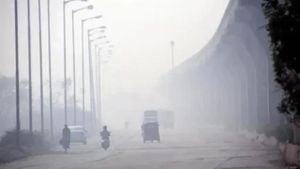Hurricane Helene made landfall with unexpected ferocity, unleashing torrential rains and high winds across the Southeast, leaving devastation and despair in its wake. The hurricane, which barreled through several states and particularly impacted North Carolina and Tennessee, has caused widespread flooding and knocked out power for millions, as communities grapple with the harrowing aftermath.
Across the Southeast, officials and residents alike are still piecing together the devastating impacts of Hurricane Helene, feared to be one of the most destructive storms to hit the region this year. Hundreds of thousands remain without electricity, with efforts to restore power hindered by downed lines and debris. Rescue operations are underway, but many areas remain isolated due to flooding and mudslides.
North Carolina has been one of the hardest-hit states, with 100,000 people reported to be without running water. The storm has inundated wastewater treatment facilities, causing significant disruptions. Asheville, which typically boasts some of the country’s finest water supplies sourced from pristine mountain waters, has found itself grappling with water shortages. Residents are struggling without access to clean drinking water, leading to makeshift solutions such as boiling creek water or scavenging supplies.
John Erwin, who lives near Asheville, faced long waits for basic necessities. After five hours spent standing in line, he was met with no water to purchase, only sugary drinks. “It’s just not ideal,” he described. Across town, residents are relying on water distribution centers and truck deliveries of bottled water, literally scavenging for life’s most fundamental need amid the chaos.
According to local officials, drinking water distributions are being organized at schools and parks, with long lines of residents showing up to refill jugs and containers. The desperation has led to incidents where crowds swarmed after rumors of bottled water being offloaded from trucks. Some safety measures were even compromised, as police had to disperse groups scavenging from wrecked shipments.
State efforts are underway, with team contributions from FEMA and local agencies attempting to bring more fresh water supplies to the communities. Reports indicate about 7.5 million liters of bottled water have been shipped to storm-affected areas, but the efficiency of distribution is hampered by poor communication and infrastructure limitations.
Meanwhile, the grim reality of the hurricane's legacy began to surface as officials update the toll: at least 154 fatalities confirmed so far. Among them, North Carolina’s death toll sits at 61, with new reports trickling in as recovery measures intensify. Many families continue to wait for news of their loved ones as search efforts persist.
While North Carolina faced immense challenges, neighboring Tennessee also bore the storm's brunt, where entire communities were left without power and flooded roads. Hospitals and healthcare facilities are working tirelessly to restore operations, but many face shortages of prescription medications and other necessary medical supplies.
Those relying on dialysis and other time-sensitive medical treatments found it increasingly difficult to access care. With disrupted services and local pharmacies overwhelmed, prescriptions are scarce. Governor Bill Lee of Tennessee has taken executive measures to allow pharmacists to dispense up to 30-day supplies of certain medications without refills, but residents still struggle to reach pharmacies due to infrastructure damage.
Community shelters have opened to provide refuge for those displaced. Many shelters have set up emergency relief protocols to address both medical needs and housing shortages. Amid these struggles, volunteers have rallied together, using makeshift strategies, such as horseback rides for delivering aid to remote areas cut off by floodwaters.
Across the communities ravaged by Hurricane Helene, there is no question about the level of resilience displayed by residents. People have banded together, forming support networks to share resources and assist neighbors. Organizations like the Red Cross have mobilized quickly to provide care and comfort, offering food and other supplies as communities band together.
Despite the myriad challenges facing residents, grocery stores have been distributing free meals, and volunteers continue to work with local organizations to provide for those impacted. Even as family heirlooms are damaged, photos are salvaged, and memories recovered from the ruins, spirits remain resilient.
Notably, the storm has reignited discussions around climate resiliency and infrastructure integrity. Experts point out how the repeated cycles of extreme weather, like what we are witnessing now, necessitate rapid changes and improvements to urban planning and environmental responsiveness. The conversation about adapting to climate challenges is louder than ever, as regions are forced to reckon with intensified storms and their results.
The toll of the storm will be realized over weeks and months to come as officials work to smooth the path to recovery. Meetings of local governments are occurring daily to assess needs and distribute resources efficiently. The grassroots movements and organized support show the compassion and humanity inherent to the community, binding individuals together as they navigate the storm's aftermath.
With the full extent of damage still unclear, recovery organizations are ramping up efforts. The U.S. Army Corps of Engineers and FEMA teams are on-site, coordinating with local leaders to tackle the recovery process. But as water systems buckle under the pressure, restoration is slow—compounded by the looming threat of diseases and health issues rising from contaminated waters.
It’s clear the road to recovery from Hurricane Helene will be long, demanding, and often overwhelming. Yet among the ruins and ruins, the message from community leaders rings clear: “The time for action and solidarity is now, as we strive to rebuild and recover together.” The lasting scars of Helene serve as both reminders and catalysts for change—prompting urgent reflections on environmental challenges and community resilience.



